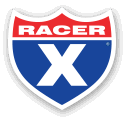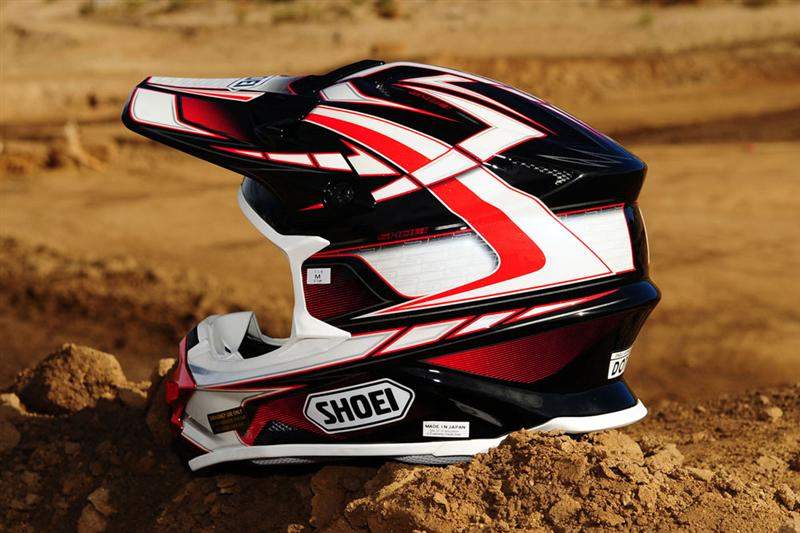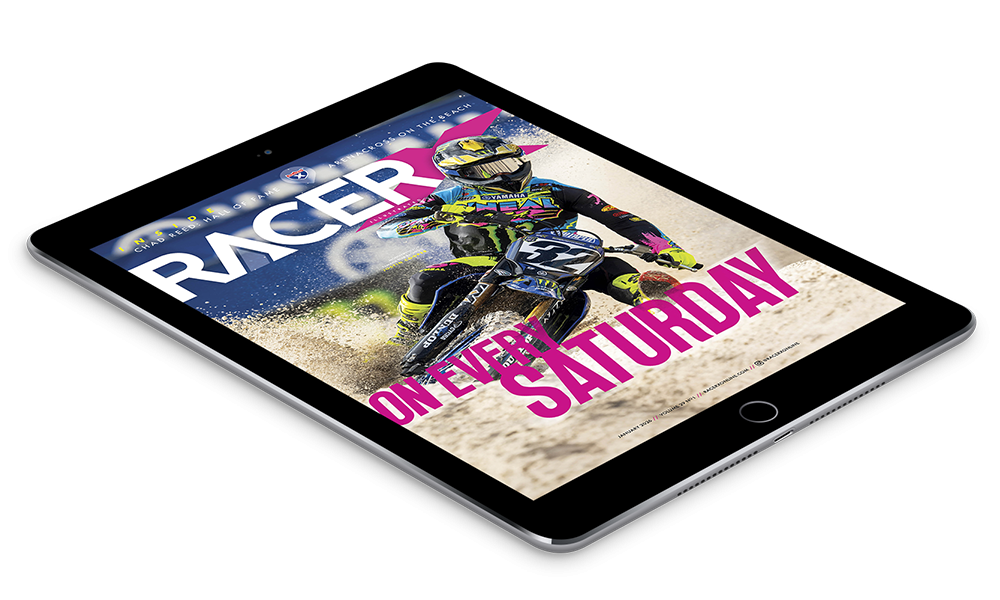Brett Milan has been around motocross for a long time. Racing with his brother, Garth, all over Southern California from his teens on, more than half of his life has revolved directly around motocross racing. Last Thursday, he had a bunch of the media types out to Perris Raceway in Perris, California, to test the new Shoei VFX-W off-road helmet, and we pulled him aside to find out a bit more about his background, and about the new helmet.
Racer X: Hey, Brett, thanks for having us out today to check out the new Shoei VFX-W helmet. Tell us, how did you get started with Shoei in the first place?
Brett Milan: Actually, I was working at Yamaha doing YZ accessory development, and it was pretty good, but it was kind of a corporate nine-to-five type thing, and I saw an ad in Cycle News where they were looking for a racing-department person at Shoei, and I was like, “That sounds like a whole lot more fun to me.” So I went and applied for that and started there, initially, doing racing service and traveling to the races and stuff. But within about three weeks of me being there, I realized that my boss, the President who was actually on the board of directors at Shoei, had no interest or knowledge of racing at all. So he said, “Here, Brett, here’s the budget, go and hire us some riders.” So I ended up doing that. From being at the track, I had developed relationships, and I have been racing since I was 17 or something like that, so I’ve been into it a long time, and I had developed good relationships with a lot of the magazine editors and stuff like that. So we had an employee previously doing the marketing and stuff, and he retired, so they gave me his job, too. Now, I’m overseeing the racing, the media relations, advertising... Basically anything that has anything to do with marketing. And when I say “overseeing” I mean I do it all myself, since I don’t really have anyone working for me.
So you don’t oversee anyone, it just sounds better to act like you’re delegating tasks to a bunch of people...
Yeah, it sounds more important [laughs].
I always assumed that you got the job because of your world-famous photographer brother Garth Milan...
Actually, back in those days, Garth wasn’t a world-famous photographer yet. He has become a world-famous photographer in the meantime [laughs].
So the two of you are turning into a bit of a two-headed monster, with Garth and his friends running a new company, and you doing so much at Shoei. Soon, you Milans are going to run everything.
Yeah, we’re kind of getting there, because since leaving Transworld, Garth went on to start the Medium Creative Group, and what do you know but nepotism started out right away there because we hired them to do some projects for us, and they’ll be building our website next year, so...
Do you work for the U.S. Government by chance?
Yeah, it’s kind of that way. Basically, we couldn’t get hired by the fire department, so we had to do something with our lives. But yeah, things are going well, and I understand that Garth’s group is doing really well and they’re staying busy, so everybody’s happy.
Brett Milan: Actually, I was working at Yamaha doing YZ accessory development, and it was pretty good, but it was kind of a corporate nine-to-five type thing, and I saw an ad in Cycle News where they were looking for a racing-department person at Shoei, and I was like, “That sounds like a whole lot more fun to me.” So I went and applied for that and started there, initially, doing racing service and traveling to the races and stuff. But within about three weeks of me being there, I realized that my boss, the President who was actually on the board of directors at Shoei, had no interest or knowledge of racing at all. So he said, “Here, Brett, here’s the budget, go and hire us some riders.” So I ended up doing that. From being at the track, I had developed relationships, and I have been racing since I was 17 or something like that, so I’ve been into it a long time, and I had developed good relationships with a lot of the magazine editors and stuff like that. So we had an employee previously doing the marketing and stuff, and he retired, so they gave me his job, too. Now, I’m overseeing the racing, the media relations, advertising... Basically anything that has anything to do with marketing. And when I say “overseeing” I mean I do it all myself, since I don’t really have anyone working for me.
So you don’t oversee anyone, it just sounds better to act like you’re delegating tasks to a bunch of people...
Yeah, it sounds more important [laughs].
I always assumed that you got the job because of your world-famous photographer brother Garth Milan...
Actually, back in those days, Garth wasn’t a world-famous photographer yet. He has become a world-famous photographer in the meantime [laughs].
So the two of you are turning into a bit of a two-headed monster, with Garth and his friends running a new company, and you doing so much at Shoei. Soon, you Milans are going to run everything.
Yeah, we’re kind of getting there, because since leaving Transworld, Garth went on to start the Medium Creative Group, and what do you know but nepotism started out right away there because we hired them to do some projects for us, and they’ll be building our website next year, so...
Do you work for the U.S. Government by chance?
Yeah, it’s kind of that way. Basically, we couldn’t get hired by the fire department, so we had to do something with our lives. But yeah, things are going well, and I understand that Garth’s group is doing really well and they’re staying busy, so everybody’s happy.
So we’re out here for the intro of the new Shoei VFX-W. Take us through some of the things that set it apart from the past incarnation of Shoei off-road helmets, and maybe all of the other helmets on the market.
First of all, the thing that sets a Shoei apart from any of our competitors’ products is the fact that Shoei’s been making helmets for close to 50 years now, and we’ve been making them ourselves in our own factory, and all of the parts and pieces that go into a Shoei are manufactured in Japan. Japanese companies have a pretty good reputation for quality and quality control, and in looking for a helmet, that’s something that’s really important. The only way to know how well your helmet is made is to break it and test it. Unfortunately, the average person doesn’t have the ability to break or test all of the helmets on the shelf before deciding which one to buy. I kind of equate it to people like this: If you had the choice between buying a car made in Japan or China, which one would you pick? It’s kind of the same thing.
I think the most interesting part is that the helmets are all true to the size that they represent: A medium helmet is a medium helmet, while a large helmet is a large helmet. A medium isn’t just a small with a thinner helmet liner.
Yeah, the EPS liner in the helmet is a two-piece unit, and the density and stiffness of the inner EPS – that’s Expanded Polystyrene, which absorbs the majority of the impact in a crash – on this particular helmet varies based on the size of the helmet. A smaller helmet will have a softer inner EPS liner and the larger helmets have a stiffer EPS liner, and that’s because the forces generated by a 100-pound rider hitting the ground head-first are completely different from the forces generated by a 200-pound rider. That two-piece EPS liner allowed Shoei engineers to really fine-tune the stiffness of the EPS. And then, with there being four separate shell sizes, as you pointed out, that allows a much more custom fit for the helmet to the rider, instead of using a larger shell and stuffing it full of padding to make it fit right. This helmet is actually the right size and shape for the individual rider, and that’s really beneficial because it allows the helmet to be physically smaller, which also allows it to be lighter.
And finally, how come you’re not riding today? What happened?
The real reason why is because we had a few people do video interviews with me today, and I figured I had to stay as clean and pretty as I could. I need all the help I could get.
You didn’t want to mess up your hair...
Yeah, exactly.
The irony of a helmet guy not wanting to be seen with helmet-hair!
That’s right! My girlfriend invested in a $17 little jar of this tea-tree styling product stuff. I’m not sure what it is, but I couldn’t waste a $17 hairstyling product by putting a helmet on it. It kind of works that way. But it’s killing me, let me tell you.
First of all, the thing that sets a Shoei apart from any of our competitors’ products is the fact that Shoei’s been making helmets for close to 50 years now, and we’ve been making them ourselves in our own factory, and all of the parts and pieces that go into a Shoei are manufactured in Japan. Japanese companies have a pretty good reputation for quality and quality control, and in looking for a helmet, that’s something that’s really important. The only way to know how well your helmet is made is to break it and test it. Unfortunately, the average person doesn’t have the ability to break or test all of the helmets on the shelf before deciding which one to buy. I kind of equate it to people like this: If you had the choice between buying a car made in Japan or China, which one would you pick? It’s kind of the same thing.
I think the most interesting part is that the helmets are all true to the size that they represent: A medium helmet is a medium helmet, while a large helmet is a large helmet. A medium isn’t just a small with a thinner helmet liner.
Yeah, the EPS liner in the helmet is a two-piece unit, and the density and stiffness of the inner EPS – that’s Expanded Polystyrene, which absorbs the majority of the impact in a crash – on this particular helmet varies based on the size of the helmet. A smaller helmet will have a softer inner EPS liner and the larger helmets have a stiffer EPS liner, and that’s because the forces generated by a 100-pound rider hitting the ground head-first are completely different from the forces generated by a 200-pound rider. That two-piece EPS liner allowed Shoei engineers to really fine-tune the stiffness of the EPS. And then, with there being four separate shell sizes, as you pointed out, that allows a much more custom fit for the helmet to the rider, instead of using a larger shell and stuffing it full of padding to make it fit right. This helmet is actually the right size and shape for the individual rider, and that’s really beneficial because it allows the helmet to be physically smaller, which also allows it to be lighter.
And finally, how come you’re not riding today? What happened?
The real reason why is because we had a few people do video interviews with me today, and I figured I had to stay as clean and pretty as I could. I need all the help I could get.
You didn’t want to mess up your hair...
Yeah, exactly.
The irony of a helmet guy not wanting to be seen with helmet-hair!
That’s right! My girlfriend invested in a $17 little jar of this tea-tree styling product stuff. I’m not sure what it is, but I couldn’t waste a $17 hairstyling product by putting a helmet on it. It kind of works that way. But it’s killing me, let me tell you.







